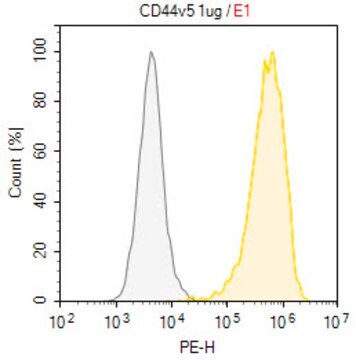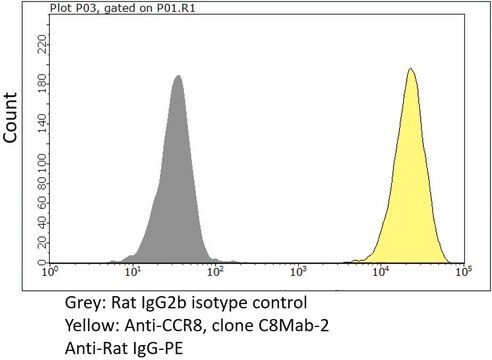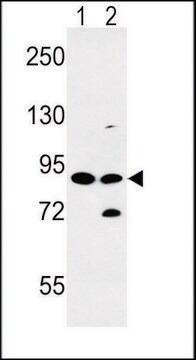Specyficzność
Klon TwMab-1 jest mysim przeciwciałem monoklonalnym wykrywającym odwrotną transkryptazę telomerazy (TERT). Celuje w epitop w obrębie 11 aminokwasów od N-końcowej połowy.
Immunogen
Liniowy peptyd sprzężony z KLH odpowiadający 11 aminokwasom z N-końcowej połowy ludzkiej odwrotnej transkryptazy telomerazy (TERT).
Zastosowanie
Testy kontroli jakości
Testowanie izotypów: Potwierdzenie tożsamości za pomocą testu izotypowania.
Analiza izotypowania: Tożsamość tego przeciwciała monoklonalnego została potwierdzona testem izotypowania jako mysie IgG1k.
Testowane zastosowania
Analiza Western Blotting: Rozcieńczenie 1:100 z reprezentatywnej partii wykryło TERT w lizacie z komórek HEK293T z ektopową ekspresją hTERT (pozytywny), ale nie w lizacie z komórek HEK293T typu dzikiego (negatywny). (Dane udostępnione dzięki uprzejmości dr Kenkichi Masutomi, National Cancer Center Research Institute, Tokio, Japonia).
Uwaga: Rzeczywiste optymalne rozcieńczenia robocze muszą być określone przez użytkownika końcowego jako próbki, a warunki eksperymentalne mogą się różnić w zależności od użytkownika końcowego.
Opis wartości docelowych
Odwrotna transkryptaza telomerazy (UniProt: O14746; znana również jako EC:2.7.7.49, HEST2, Telomerase catalytic subunit, Telomerase-associated protein 2, TP2) jest kodowana przez gen TERT (znany również jako EST2, TCS1, TRT) (Gene ID: 7015) u człowieka. Telomeraza jest enzymem rybonukleoproteinowym niezbędnym do replikacji końców chromosomów u większości eukariontów. Odwrotna transkryptaza telomerazy (TERT) jest katalityczną podjednostką telomerazy odpowiedzialną za dodawanie powtórzeń TTAGGG do końców telomerów chromosomów. Cykl katalityczny obejmuje wiązanie starterów, wydłużanie starterów i uwalnianie produktu po osiągnięciu granicy matrycy lub translokację powstającego produktu, po której następuje dalsze wydłużanie. Komórki o niskiej lub zerowej ekspresji telomerazy tracą powtórzenia telomerów podczas podziału komórkowego, co ostatecznie prowadzi do starzenia się komórek. Większość komórek nowotworowych, zarodkowych i embrionalnych komórek macierzystych wykazuje wysoki poziom telomerazy, przyczyniając się w ten sposób do pluripotencji i nieśmiertelności. Oprócz funkcji utrzymania telomerów, telomeraza odgrywa również rolę pro-przeżyciową w odporności komórkowej na uszkodzenia DNA i wynikającą z nich apoptozę. Większość komórek nowotworowych jest wysoce proliferacyjna i wykazuje wysoki poziom aktywności telomerazy jądrowej. Stwierdzono, że TERT przemieszcza się między jądrem a cytoplazmą, a to przemieszczanie zależy od cyklu komórkowego, stanu fosforylacji, transformacji i uszkodzenia DNA. TERT jest również wykrywany w mitochondriach, gdzie pomaga zapobiegać uszkodzeniom jądrowego DNA poprzez zmniejszanie mitochondrialnych reaktywnych form tlenu (ROS). Po ekspozycji na H2O2 lub napromieniowanie, komórki nowotworowe zdolne do wykluczenia TERT z jądra wykazują niewielkie lub żadne uszkodzenia DNA, podczas gdy zachowanie jądra TERT powoduje duże uszkodzenia DNA. Fosforylacja tyrozyny 707 pod wpływem stresu oksydacyjnego prowadzi do translokacji TERT do cytoplazmy i zmniejsza jego aktywność antyapoptotyczną, a jego defosforylacja przez SHP2/PTPN11 prowadzi do jego retencji jądrowej. Fosforylacja seryny 227 przez AKT promuje lokalizację jądrową. Fosforylacja TERT przy treoninie 249 jest uważana za nowy biomarker nowotworowy agresywnego raka o złym rokowaniu. (Ref.: Masuda, Y., et al. (2022). J. Pathol. 257(2); 172-185; Jacob, S., et al. (2008). J. Biol. Chem. 283(48); 33155-33161; Haendeler, J., et al. (2004). Circ. Res. 94(6); 768-775).
Postać fizyczna
Oczyszczone mysie przeciwciało monoklonalne IgG1 w buforze zawierającym 0,1 M Tris-Glicyny (pH 7,4), 150 mM NaCl z 0,05% azydkiem sodu.
Rekonstytucja
0,5 mg/ml. Należy zapoznać się ze wskazówkami dotyczącymi sugerowanych początkowych rozcieńczeń i/lub mian w zależności od zastosowania i rodzaju próbki.
Przechowywanie i stabilność
Stabilność przez 1 rok w temperaturze od +2°C do +8°C od daty otrzymania.
Inne uwagi
Stężenie: Stężenie specyficzne dla danej partii można znaleźć w certyfikacie analizy.
Oświadczenie o zrzeczeniu się odpowiedzialności
O ile nie określono inaczej w naszym katalogu lub innej dokumentacji firmy dołączonej do produktu(-ów), nasze produkty są przeznaczone wyłącznie do użytku badawczego i nie mogą być wykorzystywane do żadnych innych celów, w tym między innymi do nieautoryzowanych zastosowań komercyjnych, zastosowań diagnostycznych in vitro, zastosowań terapeutycznych ex vivo lub in vivo lub jakiegokolwiek rodzaju konsumpcji lub zastosowania u ludzi lub zwierząt.
Ta strona może zawierać tekst przetłumaczony maszynowo.









